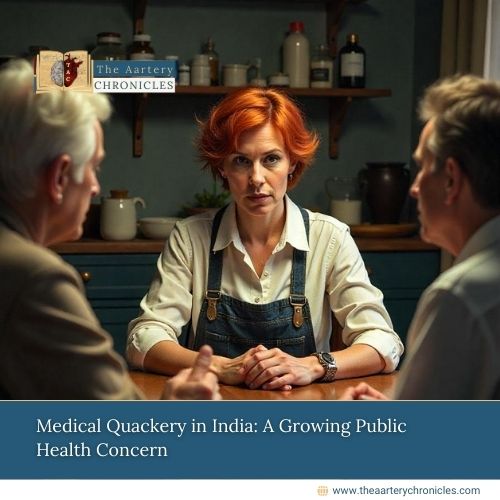

Medical Quackery in India: A Growing Public Health Concern
Introduction
India, a country with one of the largest populations in the world, faces an alarming problem in its healthcare system—medical quackery. This involves individuals who practice medicine without proper qualifications or licenses, offering unscientific and potentially dangerous treatments. While quackery is not unique to India, its prevalence is largely driven by specific socio-economic factors like a shortage of qualified doctors, inadequate healthcare infrastructure, and the unmet needs of a growing population. These factors allow unqualified practitioners to thrive, especially in rural and underserved areas.
What is Medical Quackery?
Medical quackery refers to the fraudulent or ignorant pretense of medical knowledge and practice. Quacks are unqualified individuals who masquerade as legitimate doctors and provide patients with treatments that can be potentially dangerous. These practices can range from offering fake cures for serious diseases to administering harmful drugs or treatments, all while preying on the vulnerability and desperation of patients.
Causes of Medical Quackery in India
Medical quackery in India is driven by a combination of systemic challenges and socio-economic factors that make the population vulnerable to unqualified practitioners. Some of the most prevalent factors include:
1. Shortage of Qualified Doctors
India suffers from a significant shortage of healthcare professionals, particularly in rural and semi-urban areas. According to the World Health Organization (WHO), there should be one doctor for every 1,000 people. However, in India, the doctor-to-patient ratio is far below this recommendation, especially in rural regions where the ratio can be as low as one doctor for every 10,000 people. This creates a huge gap in medical services, which quacks often exploit, posing as legitimate healthcare providers.
2. Inadequate Healthcare Infrastructure
Along with the shortage of doctors, India’s healthcare infrastructure is insufficient to meet the needs of its vast population. Government-run hospitals and clinics are often understaffed and underfunded, particularly in rural areas. Long wait times, overcrowded facilities, and a lack of basic medical supplies force many patients to seek quicker, more accessible options, making them easy targets for quacks who operate without regulation or oversight.
3. High Cost of Private Healthcare
For those who do have access to qualified doctors, the cost of private healthcare can be prohibitive. India has a thriving private healthcare system, but it is often expensive and out of reach for many middle- and lower-income families. In contrast, quacks offer cheaper, though often ineffective or harmful, alternatives.
4. Cultural and traditional beliefs
Many quacks exploit traditional beliefs, promoting remedies that are unscientific but popular in certain communities. In India, where traditional medicine systems like Ayurveda, Siddha, and Unani are deeply ingrained, it becomes easy for unqualified individuals to falsely present themselves as practitioners of these systems, offering fake cures for serious illnesses.
5. Desperation for Quick Cures
Patients with chronic or life-threatening conditions, such as cancer or infertility, may become desperate for solutions. Quacks take advantage of this vulnerability, promising miraculous cures or faster recoveries with unproven and unsafe treatments.
6. Lack of Awareness
Many patients, especially in rural areas, are unaware of the credentials needed to be a licensed doctor. This lack of knowledge allows quacks to easily pose as medical professionals without being questioned by their patients.

Common Practices of Medical Quackery in India
While there are no national surveys to determine the exact number of unqualified doctors in India, regional studies suggest that over 70% of healthcare providers in rural areas lack formal medical training. Some common instances of medical quackery practices seen in India are as follows:
- Unqualified Medical Practitioners in Rural Areas: In 2018, an unqualified doctor in Uttar Pradesh was found to have infected nearly 40 people with HIV after using single contaminated needles during treatment for all his patients.
- Medical Malpractice: In 2020, the Aurangabad bench of the Bombay High Court refused to grant relief to an individual whose allopathic prescription resulted in a patient’s death. The defendant, who also asserted qualifications as an Ayurveda graduate, was held accountable for practicing beyond the scope of his purported expertise.
- Covid-19 Quacks: During the pandemic, numerous cases were reported of individuals selling fake COVID-19 treatments. For instance, a man was arrested in 2020 for misleading patients with cough and cold symptoms into believing they had COVID-19, selling them unverified preventive medications.
- Weight Loss Quackery: In 2019, a large-scale investigation revealed a network of individuals in various states selling weight loss supplements that contained harmful substances. These products were marketed as safe and effective but led to severe health complications for many users, including liver damage and cardiovascular issues.
- Unlicensed fertility clinics: With fertility treatments becoming increasingly popular in India, many unlicensed fertility clinics promise miraculous results. Some of these clinics offer herbal remedies or unproven hormone treatments that can cause severe health issues, including ovarian hyperstimulation or infections.
Consequences of Medical Quackery
As unqualified practitioners exploit vulnerable individuals seeking relief from ailments, the consequences can be dire. One of the most alarming outcomes of medical quackery is the potential harm to patients’ health. Patients who seek treatments from unqualified practitioners may receive incorrect diagnoses or ineffective treatments, resulting in worsened health conditions, delayed appropriate medical care, or even life-threatening complications. Quacks primarily target poor, uneducated, and rural populations who are often unaware of the risks involved in seeking treatment from unqualified individuals. They exploit people’s desperation, especially those suffering from chronic illnesses or those without access to proper medical care. This not only leads to financial exploitation but also deepens the mistrust in formal healthcare systems.
Quacks often promote unverified treatments and pseudoscientific claims, contributing to the dissemination of health misinformation. This can lead to a misguided understanding of health and wellness among the public, undermining efforts to promote vaccination, disease prevention, and public health education. Patients may be swayed by false promises instead of adhering to scientifically-backed practices. The psychological toll of medical quackery is often overlooked but can be profound. Patients who invest time and resources in ineffective treatments may experience feelings of hopelessness and despair when their conditions worsen instead of improving.
Medical quackery erodes public trust in the healthcare system. Once patients fall victim to fake treatments, they often become wary of seeking help from even legitimate medical practitioners, creating a cycle of mistrust and harm. In some cases, patients resort to home remedies or self-medication rather than seeking professional medical advice. Fraudulent individuals frequently employ deceptive strategies to persuade the public, which can undermine the principles of modern medical ethics. This can lead to significant repercussions for both the healthcare industry and society at large.
Tackling Medical Quackery in India
Addressing medical quackery requires a multi-pronged approach that combines stricter law enforcement, public awareness, and improved access to qualified healthcare. Here are a few solutions:
Stronger regulatory mechanisms
While laws exist to curb quackery, their implementation is often weak. The government needs to ensure stronger enforcement of the Indian Medical Council Act, including increasing penalties for quacks and setting up dedicated task forces to track and shut down illegal clinics.
Public Awareness Campaigns
Education is key to combating quackery. The government, along with NGOs and healthcare organizations, should conduct large-scale awareness campaigns to educate people about the dangers of quack treatments and the importance of verifying a healthcare provider’s credentials.
Improved Access to Healthcare in Rural Areas
The root cause of quackery often lies in the lack of healthcare facilities in rural and underserved areas. Improving access to qualified healthcare professionals through mobile clinics, telemedicine, and rural healthcare programs can provide alternatives to quacks.
Use of Technology for Verification
The government can implement mobile apps or online databases that allow patients to verify the credentials of medical practitioners. This would enable people to easily differentiate between licensed doctors and quacks.
Conclusion
Medical quackery is a pervasive problem in India, posing serious risks to public health. As the healthcare landscape evolves, it is crucial to strengthen regulations, increase awareness, and improve access to qualified medical care, especially in rural areas. While it may take time to fully eradicate quackery, concerted efforts from both the government and society can significantly reduce its harmful impact.









